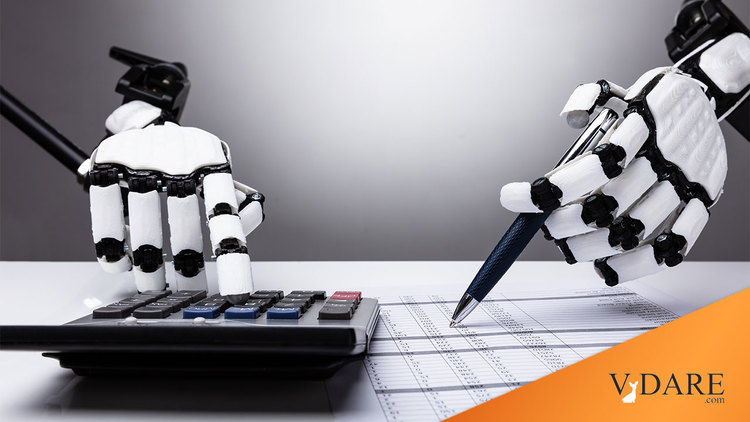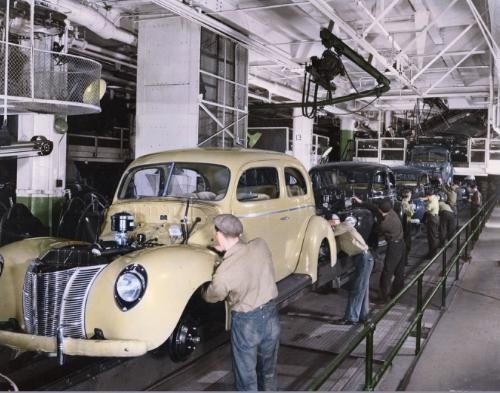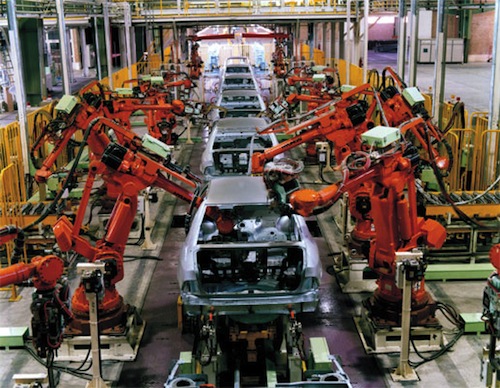


03/22/2021
America’s newspaper of record had an interesting item earlier this month titled “The Robots Are Coming for Phil in Accounting.”The New York Times apparently meant to remind readers that smart machines aren’t just coming for simple manufacturing jobs, but also for the office gigs that require education.
True, it’s easier to imagine physical robots replacing humans rather than just a little software stuck into a computer, but both threaten the basis of the economy now and into the future.
A few decades back, American workers built the nation’s cars:

But now, machines are cheaper and don’t require lunch breaks or expensive health insurance:

The economic shift toward automation and artificial intelligence will only grow. With that trend in mind, America’s future is endangered by the current government’s policy of opening the border and welcoming the world’s poor and uneducated, the number of which continues to grow into the billions.
Furthermore, a 2018 Gallup Poll showed that 158 million persons worldwide would like to relocate to the United States. So Biden’s open borders will have many takers — and there’s no visa required.
Remember:
Automation Makes Immigration Obsolete
The new technology is indeed transforming the world, but Washington does not seem to notice.
The Robots Are Coming for Phil in Accounting, New York Times, March 6, 2021
The robots are coming. Not to kill you with lasers, or beat you in chess, or even to ferry you around town in a driverless Uber.
These robots are here to merge purchase orders into columns J and K of next quarter’s revenue forecast, and transfer customer data from the invoicing software to the Oracle database. They are unassuming software programs with names like “Auxiliobits — DataTable To Json String,” and they are becoming the star employees at many American companies.
Some of these tools are simple apps, downloaded from online stores and installed by corporate I.T. departments, that do the dull-but-critical tasks that someone named Phil in Accounting used to do: reconciling bank statements, approving expense reports, reviewing tax forms. Others are expensive, custom-built software packages, armed with more sophisticated types of artificial intelligence, that are capable of doing the kinds of cognitive work that once required teams of highly-paid humans.
White-collar workers, armed with college degrees and specialized training, once felt relatively safe from automation. But recent advances in A.I. and machine learning have created algorithms capable of outperforming doctors, lawyers and bankers at certain parts of their jobs. And as bots learn to do higher-value tasks, they are climbing the corporate ladder.
The trend — quietly building for years, but accelerating to warp speed since the pandemic — goes by the sleepy moniker “robotic process automation.” And it is transforming workplaces at a pace that few outsiders appreciate. Nearly 8 in 10 corporate executives surveyed by Deloitte last year said they had implemented some form of R.P.A. Another 16 percent said they planned to do so within three years.
Most of this automation is being done by companies you’ve probably never heard of. UiPath, the largest stand-alone automation firm, is valued at $35 billion — roughly the size of eBay — and is slated to go public later this year. Other companies like Automation Anywhere and Blue Prism, which have Fortune 500 companies like Coca-Cola and Walgreens Boots Alliance as clients, are also enjoying breakneck growth, and tech giants like Microsoft have recently introduced their own automation products to get in on the action.
Executives generally spin these bots as being good for everyone, “streamlining operations” while “liberating workers” from mundane and repetitive tasks. But they are also liberating plenty of people from their jobs. Independent experts say that major corporate R.P.A. initiatives have been followed by rounds of layoffs, and that cutting costs, not improving workplace conditions, is usually the driving factor behind the decision to automate.
Craig Le Clair, an analyst with Forrester Research who studies the corporate automation market, said that for executives, much of the appeal of R.P.A. bots is that they are cheap, easy to use and compatible with their existing back-end systems. He said that companies often rely on them to juice short-term profits, rather than embarking on more expensive tech upgrades that might take years to pay for themselves.
“It’s not a moonshot project like a lot of A.I., so companies are doing it like crazy,” Mr. Le Clair said. “With R.P.A., you can build a bot that costs $10,000 a year and take out two to four humans.”
Covid-19 has led some companies to turn to automation to deal with growing demand, closed offices, or budget constraints. But for other companies, the pandemic has provided cover for executives to implement ambitious automation plans they dreamed up long ago.
“Automation is more politically acceptable now,” said Raul Vega, the chief executive of Auxis, a firm that helps companies automate their operations. (Continues)